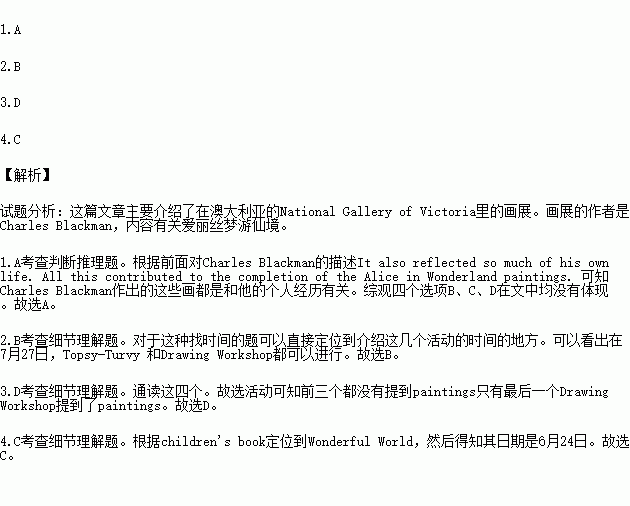题目内容
Charles Blackman:Alice in Wonderland
An Exhibition at the National Gallery of Victoria (NGV),Australia
10 June —12 August 2015
Venue (地点) The Ian Potter Centre
Admission Free entry
Charles Blackman is famous for his beautiful painting of dreams. In 1956, he heard for the first time Lewis Carroll’s extraordinary tale of Alice in Wonderland –the story of a Victorian girl who falls down a rabbit hole, meets a lot of funny characters and experiences all kinds of things. At that time, Blackman’s wife was suffering form progressive blindness. The story of Alice moving through the strange situations, often disheartened by various events, was similar to his wife’s experiences. It also reflected so much of his own life. All this contributed to the completion of the Alice in Wonderland paintings.
Illustrator Workshop
Go straight to the experts for an introductory course in book illustration. The course includes an introduction to the process of illustration and its techniques, workshop exercise and group projects.
Dates Sunday 17 June &Sunday 5Aug.10am—1pm
Venue Gas Works Arts Park
Wonderful World
Celebrate the exhibition and Children’s Book Week with special activities just for the day, including a special visit from Alice and the White Rabbit
Date Sunday 24 June, 11am—4pm
Venue Exhibition Space, Level 3
Topsy-Turvy
Visit the exhibition or discover wonderful curiosities in artworks in the NGV Collection and make a magic world in a box. Alice and the White Rabbit will be with you. Walt Disney’s Alice in Wonderland will be screened.
Dates Sunday 8,15,22,29 July, and Tuesday 24-Friday 27 July, 12noon—3pm
Venue Theatre, NGV Australia
Drawing Workshop
Distortions of scale ( 比例失真) can make artworks strange but interesting. Find out how Charles Blackman distorted scale in his paintings to create a curious world. Then experiment with scale in your own drawings. More information upon booking.
Date Friday 27 July, 10:30am-3pm
Venue Foyer, Level 3
1.Charles Blackman’s paintings come from ________.
A. his wish to express his own feelings
B. his dream of becoming a famous artist
C. his admiration for Lewis Carroll
D. his eagerness to cure his wife’s illness
2.Which two activities can you participate in on the same day?_________
A. Illustrator Workshop and Drawing Workshop.
B. Topsy-Turvy and Drawing Workshop.
C. Wonderful World and Topsy –Turvy.
D. Illustrator Workshop and Wonderful World.
3.To understand the Alice in Wonderland paintings, you should go to ________.
A. Exhibition Space .Level 3 B. Gas Works Arts Park
C. Theatre, NGV Australia D. Foyer, Level 3
4.Activities concerning children’s books are to be held
A. on July 24, 2015 B. on July15, 2015
C. on June 24, 2015 D. on August 5, 2015
写作
你所在的城市最近计划修建地铁,这件事引发了人们的广泛争论。请根据所给信息写一篇英文报道,陈述人们的不同看法,并表明自己的观点。
赞成观点 | 反对观点 | 你的观点 |
1. 交通拥堵问题,方便市民生活。 2. 提供新的交通方式,促进环境保护。 | 1.建设时间长,影响交通。 2.投入资金过大,成本回收过慢。 | …… |
注意:1.开头已给出,但不计入总词数;2.词数120左右。
3.不要逐句翻译,可适当增加内容以使行文连贯;
Recently,people are having an argument on whether a subway should be built or not in the city. Opinions vary from person to person.

